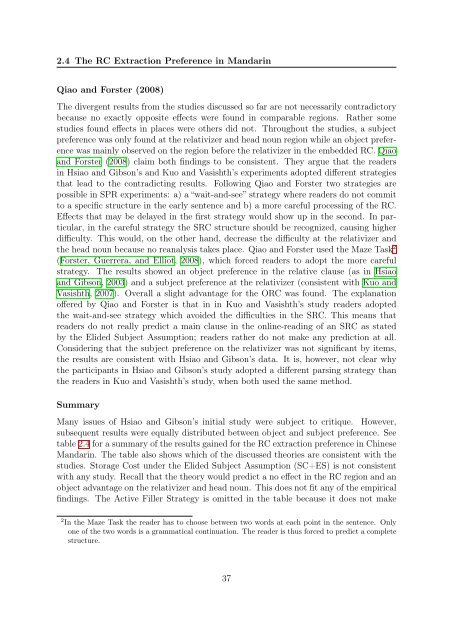Connectionist Modeling of Experience-based Effects in Sentence ...
Connectionist Modeling of Experience-based Effects in Sentence ...
Connectionist Modeling of Experience-based Effects in Sentence ...
Create successful ePaper yourself
Turn your PDF publications into a flip-book with our unique Google optimized e-Paper software.
2.4 The RC Extraction Preference <strong>in</strong> Mandar<strong>in</strong><br />
Qiao and Forster (2008)<br />
The divergent results from the studies discussed so far are not necessarily contradictory<br />
because no exactly opposite effects were found <strong>in</strong> comparable regions. Rather some<br />
studies found effects <strong>in</strong> places were others did not. Throughout the studies, a subject<br />
preference was only found at the relativizer and head noun region while an object preference<br />
was ma<strong>in</strong>ly observed on the region before the relativizer <strong>in</strong> the embedded RC. Qiao<br />
and Forster (2008) claim both f<strong>in</strong>d<strong>in</strong>gs to be consistent. They argue that the readers<br />
<strong>in</strong> Hsiao and Gibson’s and Kuo and Vasishth’s experiments adopted different strategies<br />
that lead to the contradict<strong>in</strong>g results. Follow<strong>in</strong>g Qiao and Forster two strategies are<br />
possible <strong>in</strong> SPR experiments: a) a “wait-and-see” strategy where readers do not commit<br />
to a specific structure <strong>in</strong> the early sentence and b) a more careful process<strong>in</strong>g <strong>of</strong> the RC.<br />
<strong>Effects</strong> that may be delayed <strong>in</strong> the first strategy would show up <strong>in</strong> the second. In particular,<br />
<strong>in</strong> the careful strategy the SRC structure should be recognized, caus<strong>in</strong>g higher<br />
difficulty. This would, on the other hand, decrease the difficulty at the relativizer and<br />
the head noun because no reanalysis takes place. Qiao and Forster used the Maze Task 2<br />
(Forster, Guerrera, and Elliot, 2008), which forced readers to adopt the more careful<br />
strategy. The results showed an object preference <strong>in</strong> the relative clause (as <strong>in</strong> Hsiao<br />
and Gibson, 2003) and a subject preference at the relativizer (consistent with Kuo and<br />
Vasishth, 2007). Overall a slight advantage for the ORC was found. The explanation<br />
<strong>of</strong>fered by Qiao and Forster is that <strong>in</strong> <strong>in</strong> Kuo and Vasishth’s study readers adopted<br />
the wait-and-see strategy which avoided the difficulties <strong>in</strong> the SRC. This means that<br />
readers do not really predict a ma<strong>in</strong> clause <strong>in</strong> the onl<strong>in</strong>e-read<strong>in</strong>g <strong>of</strong> an SRC as stated<br />
by the Elided Subject Assumption; readers rather do not make any prediction at all.<br />
Consider<strong>in</strong>g that the subject preference on the relativizer was not significant by items,<br />
the results are consistent with Hsiao and Gibson’s data. It is, however, not clear why<br />
the participants <strong>in</strong> Hsiao and Gibson’s study adopted a different pars<strong>in</strong>g strategy than<br />
the readers <strong>in</strong> Kuo and Vasishth’s study, when both used the same method.<br />
Summary<br />
Many issues <strong>of</strong> Hsiao and Gibson’s <strong>in</strong>itial study were subject to critique. However,<br />
subsequent results were equally distributed between object and subject preference. See<br />
table 2.4 for a summary <strong>of</strong> the results ga<strong>in</strong>ed for the RC extraction preference <strong>in</strong> Ch<strong>in</strong>ese<br />
Mandar<strong>in</strong>. The table also shows which <strong>of</strong> the discussed theories are consistent with the<br />
studies. Storage Cost under the Elided Subject Assumption (SC+ES) is not consistent<br />
with any study. Recall that the theory would predict a no effect <strong>in</strong> the RC region and an<br />
object advantage on the relativizer and head noun. This does not fit any <strong>of</strong> the empirical<br />
f<strong>in</strong>d<strong>in</strong>gs. The Active Filler Strategy is omitted <strong>in</strong> the table because it does not make<br />
2 In the Maze Task the reader has to choose between two words at each po<strong>in</strong>t <strong>in</strong> the sentence. Only<br />
one <strong>of</strong> the two words is a grammatical cont<strong>in</strong>uation. The reader is thus forced to predict a complete<br />
structure.<br />
37
















